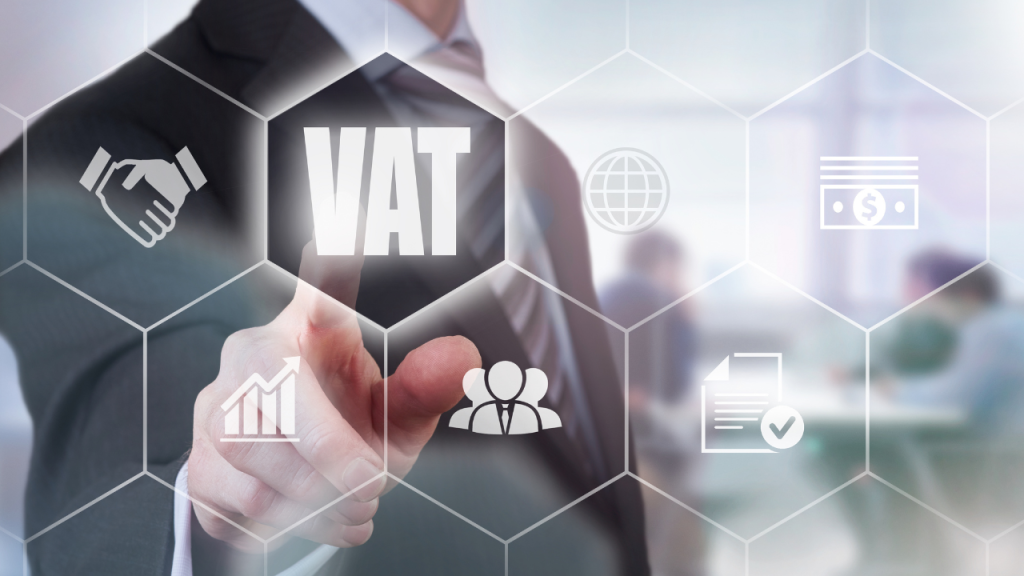
Value Added Tax (VAT) stands as a cornerstone of modern taxation systems worldwide, serving as a crucial revenue source for governments while influencing consumer behavior and business operations. This article will delve into the intricacies of VAT, its significance, and its application in both the United Kingdom and the United States.
Introduction
At its core, VAT is a consumption tax levied on the value added to goods and services at each stage of production and distribution. Unlike traditional sales taxes, which are applied solely at the point of sale to the end consumer, VAT encompasses the entire supply chain, thereby spreading the tax burden across various stages of production.
How VAT Works

Under the VAT system, businesses collect tax on behalf of the government at each point of sale. However, they are entitled to reclaim VAT paid on their inputs, ensuring that the tax is ultimately borne by the end consumer. This mechanism minimizes tax cascading and promotes efficiency within the economy. VAT rates vary across different goods and services, with some items being exempt or subject to reduced rates.
VAT in the UK
The United Kingdom adopted VAT in 1973 as a member of the European Union. Since then, it has become a fundamental component of the UK's tax regime. VAT in the UK is administered by HM Revenue & Customs (HMRC) and applies to most goods and services. The standard VAT rate stands at 20%, with reduced rates of 5% and 0% for certain goods and services.
Businesses with a turnover exceeding the VAT threshold must register for VAT and file regular returns. Failure to comply with VAT regulations can result in penalties and fines.
VAT in the US
In contrast to the UK and many other countries, the United States does not have a federal-level VAT. Instead, it relies on state-level sales taxes, which are imposed at the point of sale. While similar in function to VAT, sales taxes lack the comprehensive coverage and input tax credit mechanisms inherent to VAT systems.
Despite calls for the adoption of a federal VAT in the US, political and ideological barriers have hindered its implementation. As such, state-level sales taxes remain the primary means of generating revenue from consumption.
Advantages and Disadvantages of VAT

Advantages
1- Efficiency (VAT minimizes tax cascading and administrative burden)
VAT's mechanism of taxing at each stage of production allows for the elimination of tax cascading, where taxes are applied on top of taxes, leading to inflated prices and inefficiencies. By only taxing the value added at each stage, VAT reduces this burden. For example, consider a manufacturer who purchases raw materials for $100 and adds value worth $50 through processing. Under VAT, the manufacturer would pay tax only on the $50 value added, rather than the full $150.
2- Revenue Stability (VAT provides a reliable source of government revenue)
Unlike income taxes, which fluctuate with economic conditions and employment levels, VAT tends to provide a stable stream of revenue for governments. This stability stems from the broad base of goods and services subject to VAT and the relatively inelastic nature of consumption. During economic downturns, when income tax revenue may decline, VAT revenue remains relatively resilient as consumers continue to spend on essential goods and services.
3- Progressivity (VAT can be structured to impose a greater burden on luxury goods)
VAT systems often include provisions for reduced or zero rates on essential items like food, healthcare, and education, while applying higher rates to luxury goods and services. This progressive structure ensures that VAT places a proportionally greater burden on higher-income individuals who spend more on non-essential items. For instance, a VAT system might levy a 5% rate on groceries and a 20% rate on luxury cars, reflecting the principle of equity in taxation.
Disadvantages
1- Regressivity (VAT may disproportionately affect low-income households)
Despite its progressive structure, VAT tends to have a regressive impact on low-income households, as they spend a larger proportion of their income on essential goods subject to VAT. This regressive nature can exacerbate income inequality by placing a relatively heavier burden on those with lower incomes. For example, a household earning $30,000 per year may spend a greater portion of its income on VAT-liable goods compared to a household earning $100,000 per year.
2- Complexity (VAT regulations can be intricate and difficult to navigate)
The administration of VAT involves compliance with complex regulations regarding registration, invoicing, reporting, and remittance. Businesses must accurately determine the VAT treatment of various transactions, including exemptions, zero-rated supplies, and cross-border transactions, which can be challenging and time-consuming. Moreover, VAT regulations may vary between jurisdictions, adding an additional layer of complexity for multinational businesses operating in multiple countries. That is where expert accounting firms like Accentor Associates Limited can provide invaluable assistance, offering comprehensive solutions to navigate through these complexities with ease
3- Compliance Costs (Businesses incur expenses in complying with VAT requirements)
The implementation of VAT imposes administrative burdens on businesses, including the costs associated with record-keeping, tax filing, and compliance with reporting obligations. Small and medium-sized enterprises (SMEs) may face particular challenges in navigating VAT regulations due to limited resources and expertise. Compliance costs can also include expenses related to VAT advisory services, software systems, and staff training, further adding to the financial burden on businesses.
Conclusion

In conclusion, VAT serves as a vital instrument of fiscal policy, enabling governments to raise revenue while promoting economic efficiency. While the UK has embraced VAT as a central component of its tax system, the US continues to rely on state-level sales taxes, reflecting divergent approaches to consumption taxation. Understanding the nuances of VAT is essential for policymakers, businesses, and consumers alike, as it shapes economic behavior and government finances in profound ways. Despite its advantages, VAT poses challenges related to regressivity, complexity, and compliance costs, underscoring the importance of thoughtful design and administration in maximizing its benefits while mitigating its drawbacks.
Frequently Asked Questions (FAQs)
1- What is Value Added Tax (VAT)?
Value Added Tax (VAT) is a consumption tax levied on the value added to goods and services at each stage of production and distribution. Unlike traditional sales taxes, which are applied only at the point of sale to the end consumer, VAT covers the entire supply chain, ensuring that the tax burden is spread across various stages of production.
2- How does VAT work?
Under the VAT system, businesses collect tax on behalf of the government at each point of sale. However, they are entitled to reclaim VAT paid on their inputs, ensuring that the tax is ultimately borne by the end consumer. VAT rates vary across different goods and services, with some items being exempt or subject to reduced rates.
3- What are the main differences between VAT in the UK and the US?
In the UK, VAT is a central component of the tax system, with a standard rate of 20% and reduced rates for certain goods and services. Businesses exceeding the VAT threshold must register for VAT and comply with regulations enforced by HM Revenue & Customs (HMRC). In contrast, the US does not have a federal-level VAT and relies on state-level sales taxes, which are imposed at the point of sale.
4- What are the advantages of VAT?
- Efficiency: VAT minimizes tax cascading and administrative burden.
- Revenue Stability: VAT provides a reliable source of government revenue.
- Progressivity: VAT can be structured to impose a greater burden on luxury goods, promoting equity in taxation.
5- What are the disadvantages of VAT?
- Regressivity: VAT may disproportionately affect low-income households by imposing a relatively heavier burden on essential goods.
- Complexity: VAT regulations can be intricate and difficult to navigate, particularly for small and medium-sized enterprises (SMEs).
- Compliance Costs: Businesses incur expenses in complying with VAT requirements, including record-keeping, tax filing, and advisory services.
6- How does VAT impact businesses and consumers?
Businesses are responsible for collecting and remitting VAT to the government, which may involve additional administrative costs. Consumers bear the ultimate burden of VAT through higher prices for goods and services. However, VAT's broad base and progressive structure can promote economic efficiency and equity in taxation.
7- Are there any exemptions or reduced rates for VAT?
Yes, many countries implement exemptions or reduced rates for certain goods and services deemed essential or socially beneficial. These may include basic food items, healthcare services, and educational materials. However, the specific exemptions and rates vary between jurisdictions.
8- How can businesses ensure compliance with VAT regulations?
Businesses can ensure compliance with VAT regulations by registering for VAT where required, maintaining accurate records of transactions, issuing correct invoices, filing timely VAT returns, and seeking professional advice when necessary. Compliance with VAT regulations is essential to avoid penalties and fines imposed by tax authorities.
9- How Accentor Associates Limited can help in this regard?
In navigating the intricate landscape of VAT compliance, Accentor Associates Limited offers expert guidance and support. Our team of professionals is equipped to assist businesses in understanding and adhering to the complex regulations surrounding VAT, encompassing registration, invoicing, reporting, and remittance requirements. We provide tailored solutions to accurately determine the VAT treatment of various transactions, including exemptions, zero-rated supplies, and cross-border transactions. With our in-depth knowledge and experience, we help alleviate the challenges and time constraints associated with VAT compliance, particularly for multinational businesses operating across multiple jurisdictions. Partner with Accentor Associates Limited to streamline your VAT processes and ensure compliance with confidence. We are offering a FREE 30-minute consultancy session to discuss your specific needs. Book your session here!